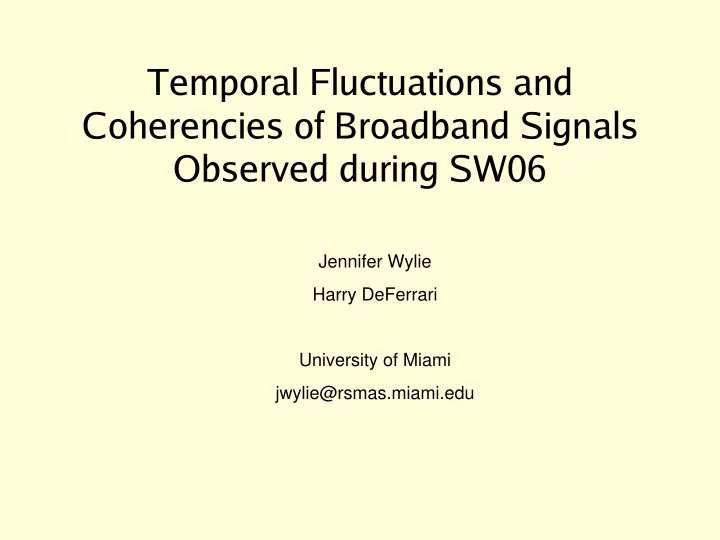

Temporal Fluctuations and Coherencies of Broadband Signals Observed during SW06 Jennifer Wylie Harry DeFerrari University of Miami jwylie@rsmas.miami.edu
Outline • Experimental Setup • Internal Wave Field Potential Energy • Temporal Coherence -Single Mode, Broadband • Data and Models -100 Hz Summary -200 Hz, 800 Hz, 1600 Hz -Determination of Modes • Summary
Experimental Setup
Internal Wave Field Potential Energy The potential energy of the internal wave field can be estimated by (Gill, 1982): 2 N 2 PE = ( r /2) h with: ' / dT / dz η = T On the NJ shelf the Buoyancy Frequency is relatively stable, so the potential energy can be estimated from η 2
Internal Wave Field Potential Energy
Temporal Coherence Temporal coherence is the statistical measure of the change of a waveform in time 2 ( p ( t )* p ( t + t ) ) D t , D T COH t , t ) = ( p ( t ) 2 D t , D T p ( t + t ) 2 D t , D T Types of Coherence: •Deterministic: slow changes in coherence, typically recoverable with phase tracking •Multipath: Deterministic but typically unrecoverable •Stochastic: Randomized by internal waves, bottom scattering, or a combination of both •Single Mode vs. Multimode -Broadband coherence: coherence of the entire pulse response
Data and Models 100 Hz Summary High IW Activity Low IW Activity •100 Hz coherency is effected by Internal Wave activity •Bottom scattering negligible, behaves as if there was a smooth bototm
100 Hz Shark VLA Data and Model C b =1595 m/s One to One mode correspondance
200 Hz
200Hz
200 Hz High IW Activity Low IW Activity
800 Hz Low IW Activity High IW Activity
800 Hz C_b=1605 m/s 1 st mode – direct path 2D PE Model @ 100m depth
1600 Hz Low IW Activity High IW Activity
Summary
Summary •100 Hz -Coherency affected by internal wave activity -Bottom scattering negligible, behaves like smooth bottom •200 Hz & 800 Hz -Bottom scattering becomes important -Direct path still affected by internal wave activity -Higher modes affected greater by bottom scattering •1600 Hz - Bottom Scattering plays the dominate role
References Gill, A. E., 1982: Atmosphere-Ocean Dynamics. Academic Press, London, United Kingdom, 661 pp Oceanus , Vol. 45, NO. 3, July 2007
Recommend
More recommend